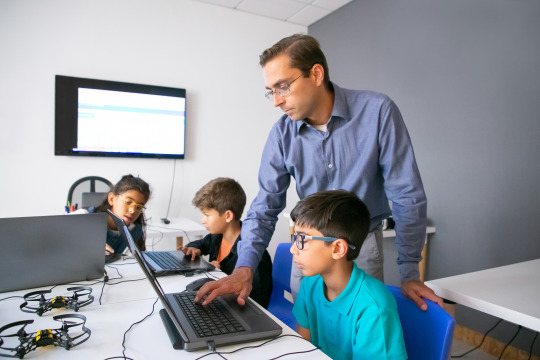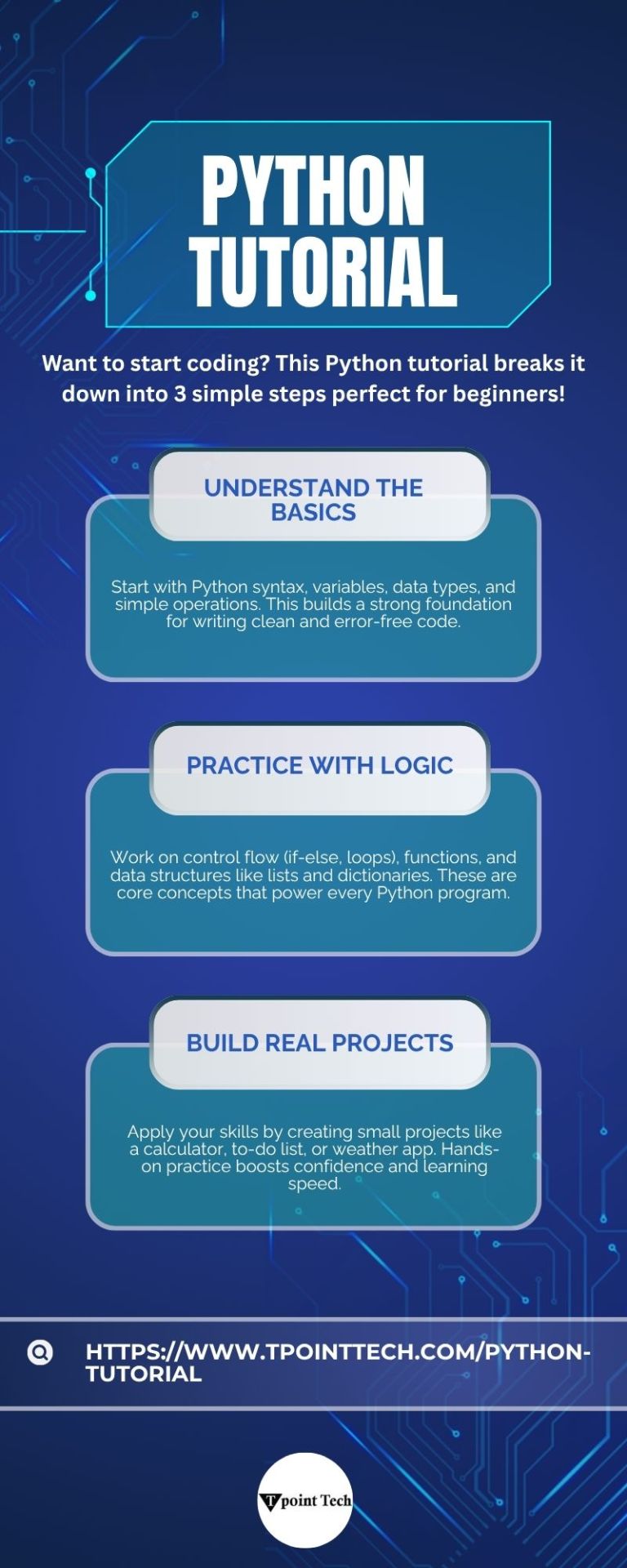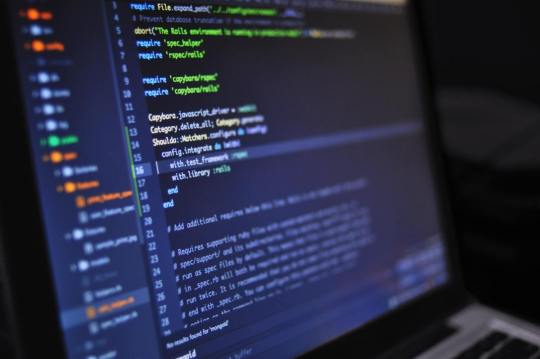#Python Programming Tutorial For Beginners
Explore tagged Tumblr posts
Text
Give Teens with Code: Codeyoung's Dynamic Computer Programming Classes.

Codeyoung's engaging and informative Computer Programming Classes For Teenagers open up a world of possibilities for your teenagers. Our expert-led courses combine fun and study, providing teens with the necessary coding skills for effectively navigating the digital environment. If you want to provide your teenagers with high-quality programming education, look at Codeyoung.
1 note
·
View note
Text
Python Tutorial - Tpoint Tech

Great Python tutorial! This guide is perfect for beginners looking to learn the basics of the Python programming language. Clear explanations and step-by-step instructions make it easy to follow. Highly recommended for anyone starting their Python journey!
0 notes
Text
Kickstart Your Coding Journey: Best Python Tutorial for Beginners in 2025

Are you new to programming and wondering where to begin? If yes, this Python Tutorial for Beginners is the perfect place to start. Python is one of the easiest and most popular programming languages today. It is widely used in web development, data science, automation, and even game development.
What makes Python great for beginners is its simple and readable syntax. Unlike other programming languages, Python looks more like plain English, making it easier to understand. You don’t need a background in coding to start learning Python. If you can follow step-by-step instructions, you're ready to go!
This Python Tutorial for Beginners will help you learn the basic concepts like variables, data types, loops, and functions without confusing technical terms. You’ll also understand how Python can be used to solve real-world problems. With time and practice, you’ll gain the confidence to create your own small projects.
Learning Python can also open up many job opportunities. Whether you want to become a software developer, data analyst, or work in AI, Python is a must-have skill.
The key to learning Python is practice. Start with simple tasks and move forward at your own pace. Don’t worry about making mistakes—that’s part of the learning process.
For a more detailed guide, visit Python Tutorial for Beginners. This resource is perfect for beginners and offers step-by-step tutorials in an easy-to-follow format. Happy learning!
0 notes
Text
Integrating Python and SAS: A Powerful Combination for Data Science
The demand for data-driven decision-making is growing rapidly, and professionals need the best tools to analyze, visualize, and process data efficiently. SAS (Statistical Analysis System) has long been a leader in statistical analysis and business intelligence, offering robust capabilities for structured data processing. On the other hand, Python has become the go-to programming language for data science, machine learning, and AI applications due to its flexibility and extensive libraries.
By integrating SAS and Python, businesses can leverage the best of both worlds, combining SAS’s structured analytical power with Python’s data science capabilities. This integration is transforming industries by enabling deeper insights, automation, and enhanced decision-making. Whether you're a data analyst, scientist, or business leader, understanding how to connect these two powerful platforms can open up new opportunities for innovation and efficiency.
Why Integrate Python with SAS?
Python and SAS offer distinct advantages that, when combined, create a powerful analytics ecosystem.
Key Advantages of SAS
Structured Data Processing: SAS provides a highly efficient environment for handling large datasets, ensuring structured data processing with reliability and accuracy.
Statistical Modeling: SAS includes advanced statistical analysis tools that are widely used in industries like finance, healthcare, and government analytics.
Enterprise-Grade Security: SAS is known for its robust security features, making it a preferred choice for organizations dealing with sensitive data.
Key Advantages of Python
Flexibility & Open-Source Ecosystem: Python’s extensive libraries like Pandas, NumPy, TensorFlow, and Scikit-learn make it a versatile choice for data science and AI applications.
Advanced Machine Learning Capabilities: Python excels in deep learning, natural language processing (NLP), and predictive analytics.
Visualization & Reporting: Libraries like Matplotlib and Seaborn allow users to create interactive and insightful visual reports.
How Integration Enhances Data Science
By combining the strengths of SAS and Python, businesses can:
Automate Workflows: Use Python scripts to preprocess data, then run statistical models in SAS.
Enhance Analytics Capabilities: Integrate machine learning algorithms in Python with SAS’s statistical tools for deeper insights.
Optimize Decision-Making: Leverage both structured SAS data and unstructured data sources processed through Python for a holistic analytical approach.
For professionals looking to master this integration, SAS Programming Tutorial resources provide step-by-step guidance on leveraging Python with SAS efficiently.
How Python and SAS Work Together
There are several ways to integrate SAS and Python, depending on business needs and technical requirements.
1. SASPy – Python Library for SAS
SASPy is an open-source Python package that allows users to connect to SAS and run SAS code within Python scripts. It bridges the gap between the two platforms by enabling:
Direct execution of SAS commands within Python.
Import and manipulation of SAS datasets in Python environments.
Seamless interaction between SAS procedures and Python functions.
This method is ideal for data scientists who prefer coding in Python but still want to leverage SAS’s structured analytics capabilities.
2. Jupyter Notebook with SAS Kernel
Jupyter Notebook is a widely used tool in the data science community. By installing the SAS Kernel, users can:
Write and execute SAS code directly in Jupyter.
Combine Python and SAS scripts within the same document.
Create interactive data visualizations using Python’s powerful plotting libraries.
This integration is particularly useful for researchers and analysts who require a collaborative, interactive environment for data exploration and reporting.
3. Using REST APIs for SAS Viya
SAS Viya is a cloud-based analytics platform that supports REST APIs, allowing Python applications to communicate with SAS. Businesses can:
Access SAS functions from Python-based dashboards or applications.
Deploy machine learning models built in Python within SAS environments.
Scale big data analytics using cloud-based infrastructure.
This approach is highly beneficial for organizations that require scalable and automated data processing capabilities.
Key Benefits of SAS and Python Integration
By integrating SAS and Python, businesses unlock several advantages:
Enhanced Flexibility
Python’s open-source nature allows for customization and scalability, complementing SAS’s structured analytics.
Advanced Data Processing
Python’s data science libraries enhance SAS’s data handling capabilities, allowing for more complex and faster analysis.
Improved Visualization
Python’s Matplotlib, Seaborn, and Plotly enable richer, interactive reports compared to SAS’s traditional visualization tools.
Powerful Machine Learning
Python’s TensorFlow and Scikit-learn support AI and deep learning, which can be integrated into SAS analytics workflows.
Use Cases of Python and SAS Integration
Many industries benefit from combining SAS and Python for data analytics and decision-making.
1. Healthcare Analytics
Python processes electronic health records (EHRs), while SAS builds predictive models to forecast disease outbreaks.
AI-powered analysis in Python detects patterns in patient data, allowing for early diagnosis and treatment planning.
2. Financial Fraud Detection
Python’s machine learning models analyze transaction patterns for anomalies.
SAS ensures compliance with regulatory standards while improving fraud detection accuracy.
3. Retail Customer Insights
Python clusters customer data for segmentation and personalized marketing.
SAS refines sales strategies based on customer analytics, optimizing demand forecasting.
These real-world applications highlight how Python and SAS together create smarter, data-driven solutions.
Challenges and Best Practices
Despite its advantages, integrating Python with SAS comes with challenges that businesses must address:
1. Version Compatibility
Ensure Python libraries support SAS environments to avoid compatibility issues.
Regularly update SAS and Python packages for smoother integration.
2. Performance Optimization
Use cloud-based SAS Viya for processing large datasets efficiently.
Optimize Python scripts to reduce execution time within SAS environments.
3. Security Concerns
Implement authentication and encryption when transferring data between SAS and Python.
Follow data governance policies to maintain compliance with industry regulations.
Organizations can overcome these challenges by following structured learning paths, such as SAS Tutorial Online, to build expertise in both platforms.
Future of Python and SAS Collaboration
The future of data analytics lies in hybrid approaches that blend different technologies. As AI, big data, and cloud computing continue to evolve, the demand for Python and SAS integration will grow. Businesses that embrace this collaboration will lead in innovation, leveraging real-time analytics, predictive modeling, and automation for better decision-making.
By mastering SAS and Python together, data professionals can build cutting-edge solutions that drive efficiency and business success.
#sas tutorial#sas programming tutorial#python#sas tutorial online#sas and python#sas tutorial for beginners
0 notes
Text
Getting Started with Python: Project 0 - “Hello, World”
Discover how to make your Python scripts more interactive and start your programming journey with confidence. Your support is much appreciated for me to get more content out for you! 😄👍🏽
Consider reviewing the basics with the following content: Getting Started with Python: Project 0 – “Hello, World” Getting Started with Python: A Beginner’s Guide pt3 Getting Started with Python: A Beginner’s Guide (pt 2) Getting Started with Python: A Beginner’s Guide (pt 1) Terminal Window – Command Line Interface This tutorial uses Visual Studio Code: To create and edit a Python file, use…

View On WordPress
#Beginner#Coding#Errors#Functions#Getting started with Python#Interactive Scripts#Learn Python#Learning Python#Programming#Python#Python basics#Python for beginners#Tutorial
0 notes
Text
Python programming for beginners
Python programming for beginners
What is Python?
Python is an undeniable level, deciphered programming language made by Guido van Rossum and first delivered in 1991. It is planned with an accentuation on code coherence, and its linguistic structure permits developers to communicate ideas in less lines of code than would be conceivable in dialects like C++ or Java. Python upholds numerous programming standards, including procedural, object-situated, and utilitarian programming. In less difficult terms, this implies it's adaptable and permits you to compose code in various ways, whether that resembles giving the PC a plan for the day (procedural), making computerized models of things or ideas (object-situated), or dealing with your code like a numerical question (useful).

The main features of Python
We should have a nearby glance at a portion of the Python includes that make it such a flexible and broadly utilized programming language:
Coherence.
Python is known for its reasonable and discernible language structure, which looks like English partially.
Simple to learn.
Python's clarity makes it moderately simple for novices to get the language and comprehend what the code is doing.
Adaptability.
Python isn't restricted to one kind of undertaking; you can involve it in many fields. Whether you're keen on web advancement, computerizing undertakings, or plunging into information science, Python has the devices to assist you with arriving.
Rich library support.
It accompanies a huge standard library that incorporates pre-composed code for different undertakings, saving you time and exertion.
Moreover, Python's dynamic local area has created large number of outsider bundles, which expand Python's usefulness significantly further.
Stage autonomy.
An extraordinary aspect regarding the language is that you can compose your code once and run it on any working framework.
This element pursues Python an incredible decision in the event that you're dealing with a group with various working frameworks.
Deciphered language.
Python is a deciphered language, and that implies the code is executed line by line. This can make troubleshooting simpler in light of the fact that you can test little bits of code without ordering the entire program.
Open source and free.
It's additionally an open-source language, and that implies its source code is unreservedly accessible and can be dispersed and changed.
This has prompted an enormous local area of engineers adding to its turn of events and making a huge biological system of Python libraries.
Progressively composed.
Python is progressively composed, meaning you don't need to pronounce the information kind of a variable when you make it. The Python translator deduces the sort, which makes the code more adaptable and simple to work with.
Why is learning Python so useful?
Learning Python is useful for different reasons. Other than its wide fame, Python has applications in various enterprises, from tech to fund, medical care, and then some. Learning Python opens up many profession open doors and ensures further developed vocation results.
Contact us: 8600028849
#Python For Beginners#Python Courses & Tutorials#Python for beginners - Training#Best Online Python Courses and Programs#Python Course and Certification Online#Best Python Classes in Nagpur#Python Courses and Tutorials
0 notes
Text
Learn the art of web scraping with Python! This beginner-friendly guide covers the basics, ethics, legal considerations, and a step-by-step tutorial with code examples. Uncover valuable data and become a digital explorer.
#API#BeautifulSoup#Beginner’s Guide#Data Extraction#Data Science#Ethical Hacking#Pandas#Python#Python Programming#Requests#Tutorial#Web Crawler#web scraping
1 note
·
View note
Text
Get Started with Python: The Ultimate Beginner's Tutorial
The Ultimate Beginner’s Tutorial to Python Programming Welcome to this blog post. Here we will learn the fundamentals of Python programming, making it accessible to individuals with no prior coding experience. Whether you’re a student, professional, or simply curious about learning a new skill, this tutorial will provide you with a solid foundation in Python programming. So, let’s embark on this…

View On WordPress
0 notes
Text
Building a Python-Powered GPS Tracking Device for Bikes
A few months ago, a bike of my friend got stolen on the streets. He had parked his bike to grab a quick snack from the roadside food truck but didn’t lock it, thinking who would steal it. To his misfortune, his bike did get stolen in those couple of minutes. However, this unfortunate incident fueled my determination to create a solution. While there exist amazing GPS trackers for bikes on the…

View On WordPress
0 notes
Text
Embarking on Your Python Journey
Dive into the world of programming with our beginner-friendly guide to Python, the versatile and accessible language. Discover the perfect starting point for your coding aspirations and explore how a Python course in Delhi can accelerate your learning journey.
#python for beginners#python tutorial for beginners#python programming for beginners#basics of python
0 notes
Text
Day-1: Demystifying Python Variables: A Comprehensive Guide for Data Management
Python Boot Camp Series 2023.
Python is a powerful and versatile programming language used for a wide range of applications. One of the fundamental concepts in Python, and in programming in general, is working with variables. In this article, we will explore what variables are, how to use them effectively to manage data, and some best practices for their usage. What are Variables in Python? Definition of Variables In…

View On WordPress
#best practices for variables#data management in Python#dynamic typing#Python beginners guide#Python coding tips#Python data manipulation#Python data types#Python programming#Python programming concepts#Python tutorials#Python variable naming rules#Python variables#variable scope#working with variables
0 notes
Text
learning to code!
When I was 9 years old, I learned enough html to code neopets pages, my own geocities websites, and I even made forums on my own sites so my friends could all roleplay together or rant together lol. And then? I forgot so much. I no longer no how to make a forum, or even a 'next page' button - so even the dream of just making a simple blog or webnovel site feels like a huge hurdle now. (9 year old me could probably figure it out in 2 hours).
So I'm relearning! I figured this would be a fun post to place resources I find for coding, since there's coding languages, and I figure maybe if you like running you're blog then you also might be interested in tools for making blogs!
First, for those of you who miss the old geocities and angelfire type of sites to make your own free site on: neocities.org
You can make free sites you can code yourself, the way 9 year old me did. A lot of people have made SUCH amazing sites, it's baffling my mind trying to figure out how they did, I definitely wish I could make an art portfolio site even a fourth as cool as some of the sites people have made on here.
And for those pressed for time, who aren't about to learn coding right now: wix.com is the place I recommend for building a site, it requires no coding skill and is fairly straightforward about adding pages or features by clicking buttons. I used it to make my art portfolio site, I am testing out using it for my webnovel - the alternative is Wordpress, but wix.com is letting me basically make a wordpress blog Inside my own site. It's very beginner friendly in terms of "how the fuck do I set up a 'sign up for updates' message and have my site actually email these people my novel updates?" and "I need a 4x20 grid of my art down the page, that lets people click the art to see it's information and make it bigger."
I did neocities.org's little html tutorial today, it's the part of html I DID remember (links, paragraphs, headers).
My next step is to go through htmldog.com's tutorials. They go from beginner, to intermediate, to CSS. Unlike many a coding tutorial I've seen, they explain what program on your computer you need to WRITE the code in and then how to save it and how to open it. (You'd think this isn't a big deal but I've been looking into how to learn Python for months and I can't find a tutorial explaining what fucking program to write my python in... notepad? do I need something else? I don't fucking know!! My dad finally gave me a printed textbook which supposedly tells you what to download to start... I learned C++ in college and for that you needed Visual Basic to code C++, so I figured I needed Something to Write the fucking python IN.)
#coding#rant#wooh my new CODING TAG#learning to code#i feel very. odd if im honest?#i genuinely knew how to build full fucking forum websites as a child including user sign ups#and i studied Computer Science Engineering in college so i did everything with C++ we were asked to and got As#and then i promptly BLOCKED IT OUT because i#HATED studying c++ SO fucking much. i hated my whole major. i did not like Engineering. i hated it. i was so mentally destroyed#by my college major that when i graduated i got a DIFFERENT job#and do NOTHING related to my major#i want to get into a more tech focused career eventually...since that is what my fucking degree is in#but i've been looking into something with less coding OR trying to teach myself#to like coding as long as its not fucking c++ again... i cant do it. too many bad memories#i think cybersecurity sounds like a fun job.#but u know me. im a person who likes knowing the BASICS#so i feel like i need to Relearn to code and learn python decently#before i try to study cybersecurity specific shit
36 notes
·
View notes
Note
Hya! Do any of the ppl in charge of coding have any recommendations for people who wanna learn? Looking to make my own game but not sure where to start 😅😅 ty!!
I don't work on Clangen as a coding dev, but I am working to become a programmer as a career, so maybe some of my advice might be helpful?
One thing is, What programming language are you working in? Games use a variety of programming languages depending on what they need. Clangen itself is built on Pygame, which runs on the programming language Python. Python's a more "beginner-friendly" language, due to it being written in more regular English. Lots of game engines use stuff like C# or C++ for their memory efficiency though. Choose what you need!
Either way, you'll need to learn the basics of programming before you start going nuts. I'd look up tutorials online for learning that, and make a bunch of small bad programs. You've got to practice it to do it! Also, you're going to break stuff. Don't be afraid of it. Whenever you're doing anything different, stuff is going to be slightly broken at first. You've just got to take another look and the answer might be way more obvious than you think!
✦ Chibi ✦
#clangen#ask response#warrior cats#clan generator#ask#clan gen#warriors#warrior cats generator#it's 3am. the chibi hour
71 notes
·
View notes
Text
instagram
Learning to code and becoming a data scientist without a background in computer science or mathematics is absolutely possible, but it will require dedication, time, and a structured approach. ✨👌🏻 🖐🏻Here’s a step-by-step guide to help you get started:
1. Start with the Basics:
- Begin by learning the fundamentals of programming. Choose a beginner-friendly programming language like Python, which is widely used in data science.
- Online platforms like Codecademy, Coursera, and Khan Academy offer interactive courses for beginners.
2. Learn Mathematics and Statistics:
- While you don’t need to be a mathematician, a solid understanding of key concepts like algebra, calculus, and statistics is crucial for data science.
- Platforms like Khan Academy and MIT OpenCourseWare provide free resources for learning math.
3. Online Courses and Tutorials:
- Enroll in online data science courses on platforms like Coursera, edX, Udacity, and DataCamp. Look for beginner-level courses that cover data analysis, visualization, and machine learning.
4. Structured Learning Paths:
- Follow structured learning paths offered by online platforms. These paths guide you through various topics in a logical sequence.
5. Practice with Real Data:
- Work on hands-on projects using real-world data. Websites like Kaggle offer datasets and competitions for practicing data analysis and machine learning.
6. Coding Exercises:
- Practice coding regularly to build your skills. Sites like LeetCode and HackerRank offer coding challenges that can help improve your programming proficiency.
7. Learn Data Manipulation and Analysis Libraries:
- Familiarize yourself with Python libraries like NumPy, pandas, and Matplotlib for data manipulation, analysis, and visualization.
For more follow me on instagram.
#studyblr#100 days of productivity#stem academia#women in stem#study space#study motivation#dark academia#classic academia#academic validation#academia#academics#dark acadamia aesthetic#grey academia#light academia#romantic academia#chaotic academia#post grad life#grad student#graduate school#grad school#gradblr#stemblog#stem#stemblr#stem student#engineering college#engineering student#engineering#student life#study
7 notes
·
View notes
Text
Want to learn something new
Want to learn something new in 2022??
Absolute beginner adult ballet series (fabulous beginning teacher)
40 piano lessons for beginners (some of the best explanations for piano I’ve ever seen)
Excellent basic crochet video series
Basic knitting (probably the best how to knit video out there)
Pre-Free Figure Skate Levels A-D guides and practice activities (each video builds up with exercises to the actual moves!)
How to draw character faces video (very funny, surprisingly instructive?)
Another drawing character faces video
Literally my favorite art pose hack
Tutorial of how to make a whole ass Stardew Valley esque farming game in Gamemaker Studios 2??
Introduction to flying small aircrafts
French/Dutch/Fishtail braiding
Playing the guitar for beginners (well paced and excellent instructor)
Playing the violin for beginners (really good practical tips mixed in)
Color theory in digital art (not of the children’s hospital variety)
Retake classes you hated but now there’s zero stakes:
Calculus 1 (full semester class)
Learn basic statistics (free textbook)
Introduction to college physics (free textbook)
Introduction to accounting (free textbook)
Learn a language:
Ancient Greek
Latin
Spanish
German
Japanese (grammar guide) (for dummies)
French
Russian (pretty good cyrillic guide!)

Jan 2, 2023
Want to learn something new in 2023??
Cooking with flavor bootcamp (used what I learned in this a LOT this year)
Beekeeping 101
Learn Interior Design from the British Academy of Interior Design (free to audit course - just choose the free option when you register)
Video on learning to read music that actually helped me??
How to use and sew with a sewing machine
How to ride a bike (listen. some of us never learned, and that's okay.)
How to cornrow-braid hair (I have it on good authority that this video is a godsend for doing your baby niece's black hair)
Making mead at home (I actually did this last summer and it was SO good)
How to garden
Basics of snowboarding (proceed with caution)
How to draw for people who (think they) suck at art (I know this website looks like a 2003 monstrosity, but the tutorials are excellent)
Pixel art for beginners so you can make the next great indie game
Go (back) to school
Introduction to Astronomy (high school course - free textbook w/ practice problems)
Principals of Economics (high school course - free textbook w/ practice problems)
Introduction to philosophy (free college course)
Computer science basics (full-semester Harvard course free online)
Learn a language
Japanese for Dummies (link fix from 2022)
Ukrainian
Portuguese (Brazil)
American Sign Language (as somebody who works with Deaf people professionally, I also strongly advise you to read up on Deaf/HoH culture and history!)
Chinese (Mandarin, Simplified)
Quenya (LOTR fantasy elf language)

Dec 26, 2023
Want to learn something new in 2024??
Beginner-oriented video on how to sail
This guy has so many videos on baking different types of bread. SO very many.
Coding in Python - one of the most flexible and adaptable high-level programming languages out there - explained through projects making video games
Learn to swim! (for adult learners. I don’t care if you live in Kansas or Mali or wherever. LEARN TO SWIM.)
Learn how quantum mechanics works. Then read some more about it
[Learn about quantum mechanics again, but in a more advanced engineering/mathematics class. Then read more about the math and physics of it]
Poetry Handbook, by Mary Oliver
Something I learned this year: how to sew a quilt (Here’s a very easy beginning pattern that looks amazing and can be done with pre-cut fabric!)
How to hit the ball in softball
Tutorial video on what is under the hood of most (gas) cars + weird engine sounds and what they mean
Full beginner mechanics technical training, if you want to go more in depth
Playlist on how car engine physics work if you want to go ultra in depth
Lecture series on architecture design through study of buildings
How (American income) taxes & tax law work (choose “audit course” at checkout for free class)
Pickleball for beginners (so you can finally join your neighbor/friend/distant cousin who is always insisting you join their team)
+ Para-Pickleball for beginners (for mobility aid users!)
School is so much more fun when there’s no tests:
American Law - Contracts
Shakespeare’s Life and Plays
Fairy Tales: Meanings, Messages, and Morals
Modern Poetry
World History [Part 1, Part 2]
Learn a language:
Arabic + Resource Guide compiled from Reddit (includes info on different dialects)
Chinese (Cantonese) (audio)
Urdu (frequently recommended course on Reddit) + Resource Guide
Yucatec Maya
36 notes
·
View notes
